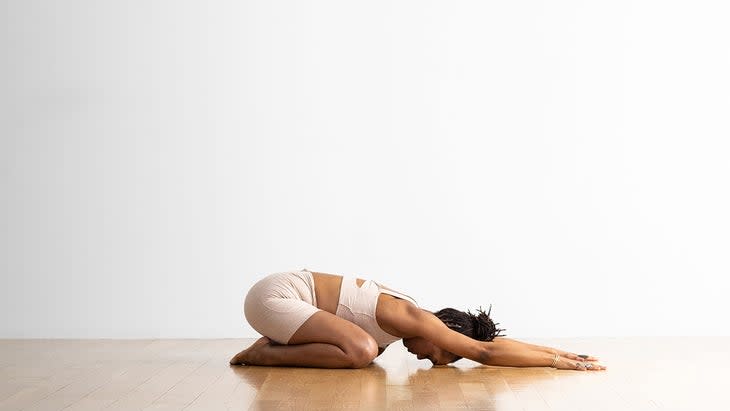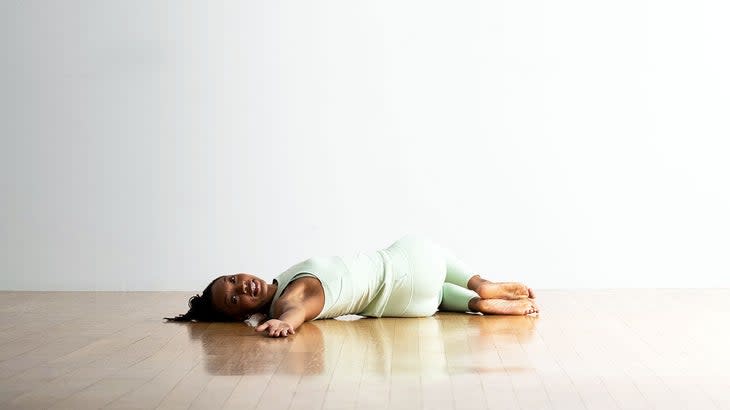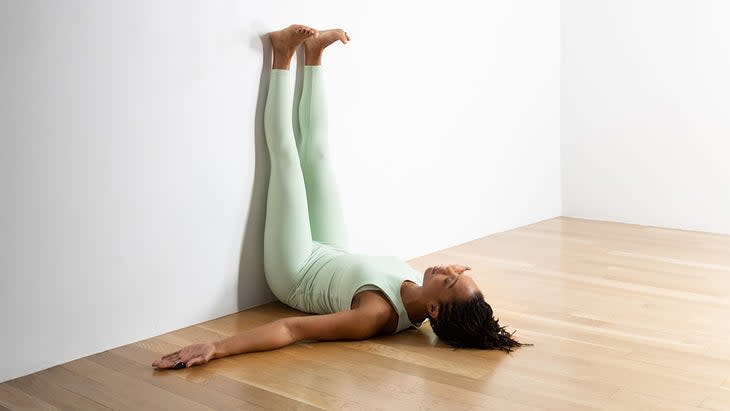3 Poses Jonathan Van Ness Turns to When He Can’t Sleep—And Why You Should, Too
- Oops!Something went wrong.Please try again later.
This article originally appeared on Yoga_Journal
Stars, they’re just like us. (In suffering from insomnia, that is.) In a recent interview with Self, Jonathan Van Ness, one of the hosts of Netflix’s Queer Eye, says he sometimes wakes up with anxious thoughts in the middle of the night. Relatable. To nudge his body back to a state of rest, Van Ness says he’ll listen to a calming podcast, a guided meditation--or move through some restorative yoga postures. “I do Child’s Pose, supine twists, and Legs up the Wall and hold each pose for three minutes or so and just breathe to calm my nervous system,” he says.
Since I aspire to have Van Ness’ confidence, charisma, and hair (of course), I wanted to emulate his restorative nighttime sequence. I reached out to Susan Raposo, a yoga teacher with expertise in restorative yoga, to find out more about Van Ness’ favorite poses.
The benefits of restorative yoga for sleep
Waking up in the middle of the night is no fun--and getting back to sleep can be difficult. Enter: restorative yoga. A restorative yoga practice can calm down your nervous system and lull you back to sleep. Raposo says restorative movement can ground you in the present moment, causing your anxieties to dissipate. If you’ve had a hectic day (hello, nighttime anxiety), you may experience thoughts about the past or the future. Restorative movement helps you focus on the present.
Unlike more active practices, she says restorative movement lets you reap the benefits of a practice--without the strenuous physical work. “It allows you to relax and nourish yourself from the inside out, as opposed to trying to strengthen a muscle or stretch your muscles,” Raposo says.
Props can help you support your body in this way, too. She recommends adding a blanket or a bolster to certain poses in order to take stress off of your body. Additionally, she says restorative practices can boost your endorphins, leading to lower levels of stress--and better overall well-being.
Jonathan Van Ness’s favorite yoga poses for better sleep

Balasana (Child’s Pose)
You may wake up in the middle of the night with some back pain. (Maybe Van Ness does, too.) If you’re experiencing back pain, Raposo says Child’s Pose is a great option for relieving that pain--and creating space across the back of your lungs. She says this restorative posture benefits your digestive system, calms you down, and gives you space to be introspective-all important elements in combatting insomnia.

Supta Matsyendrasana (Supine Spinal Twist)
If you spend all day moving from place to place (like a certain JVN), slow down with this restorative pose. Raposo says Supine Spinal Twist helps stimulate your digestive organs--and massage your torso. “One of the great physical benefits is that it gently releases the outer sides of your hips and the sides of your ribcage,” she says. She recommends starting this posture by twisting to the left to aid the direction of your digestive system.

Viparita Karani (Legs Up the Wall Pose)
Everyone’s favorite pose is also one of Van Ness’s go-to restorative postures. Raposo says this accessible inversion can calm your nervous system, rejuvenate your legs, and help circulate blood flow. “If you have swollen legs or varicose veins or experience any kind of water retention in the legs, this is great to do…at the end of the day, before you’re getting ready for bed,” she says. You can modify this posture with blankets and bolsters or opt to drape your calves over a chair if the full posture isn’t accessible to you.
What to keep in mind with a restorative practice
The next time you’re having a sleepless night--or are completely drained from the day-try Van Ness’s favorite restorative poses. Or you can choose to move through your own restorative postures. Regardless of what your practice looks like, Raposo recommends keeping these tips in mind:
Tap into your breath. Raposo says restorative practices can be challenging on your mind, as they ask you to tune into the present moment. If you struggle to stay present during a restorative practice (or pose), she recommends doing a deep breathing exercise.
Move your spine in different directions. Make sure to include different types of restorative poses into your practice in order to maintain the health of your spine, Raposo says. She recommends including a variety of forward bends, twists, backbends, and side bends.
Commit to the experience. Taking time to really engage with a restorative practice can be difficult. But finding that time is important. Raposo recommends finding tools that can help you commit to the experience, whether that’s props or deep breaths or even setting a timer.
For exclusive access to all of our fitness, gear, adventure, and travel stories, plus discounts on trips, events, and gear, sign up for Outside+ today.

